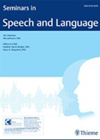
Journal Reviews
The nice therapist effect: does the therapeutic relationship matter?
Quality of relationships is considered a core component of all speech and language therapy work, yet there is little agreement of what constitutes a therapeutic relationship. This study describes a scoping review to map existing evidence that has investigated this...
Risky behaviour: do care homes follow dysphagia recommendations?
A huge proportion of elderly people living in residential care homes will develop dysphagia. In Australia this is estimated at close to two thirds of all residents. It is the role of the speech and language therapist to make recommendations...
Till death do us part: the role of the speech and language therapists in palliative care
Increasingly, speech and language therapists are being involved in end-of-life and palliative care. This study reports on a three-phase project to explore this in the context of the Australian healthcare system. In phase one, the authors described a scoping review...
Bringing aged care back
Worldwide, our older population is increasing, and thus a need for the provision of care to older people is also increasing. Aged care may be informal, provided by unpaid carers; or formal, provided or subsidised by government or other organisations....
Swallowing it whole: the physical and psychological consequences of dysphagia
Living with dysphagia in the real world can be extremely challenging, both practically and psychologically. Long-term changes in taste due to chemo-radiation treatment for head and neck cancer, fatigue due to Parkinson’s disease, and physically impaired structures due to stroke...
Pretend placements: simulation is as good as the real thing
Clinical placements are now, more than ever during the COVID-19 pandemic, a huge time and personnel commitment. Recently, allied health students have had huge changes to their placements, often undertaking them entirely remotely. This article describes a novel method of...
How long is too long? Waiting times for speech and language therapy
Waiting lists are a reality of clinical practice, and many health and social care professionals become used to having to cope with this. The authors of this paper addressed this issue by examining written submissions to the 2014 Senate Inquiry...
What do SLTs do in palliative care?
The authors of this article highlight that the number of older people has increased significantly in the last two decades, and the number of people over 85 has doubled in Australia since 1996. They attribute this to improved lifestyle factors...
What the people want and need: emerging service for communication needs in Ghana
There is a significant shortfall in rehabilitation service for people with communication difficulties across Majority World countries. It is known that many people in these countries are likely to seek help from a variety of sectors including western healthcare, religious...
Do it like a techy: telepractice in SLT for people with Parkinson’s disease
Parkinson’s disease (PD) is the second most common neurological condition in Australia, and communication difficulties are reported by 90% of people with the condition. Unfortunately, not all people with PD have access to speech and language therapy services due to...
Socially appropriate part II: therapy for people with TBI
Social communication is a complex behaviour comprising social and cognitive communication skills. Providing speech and language therapy (SLT) interventions for people with social communication difficulties following traumatic brain injury (TBI) requires the clinician to understand how ingredients from an evidence-based...
Help or hinder: how and why do SLTs make clinical decisions around swallowing?
Dysphagia is a relatively common consequence of stroke, with estimates between 50% and 60% of people presenting with swallowing dysfunction following stroke. It is associated with pneumonia, malnutrition and dehydration which in turn lead to increased length of hospital admission,...









